Striving for Perfection
Text;Charis Whitcombe
Photos:Rolls-Royce Press
When BMW Group acquired the Rolls-Royce marque four and a half years ago, all they had was a world-renowned brand and a blank piece of paper. The company committed itself to building an entirely new car from scratch, ready for launch in January 2003, and you can imagine some of the questions …… “What makes a Rolls-Royce a Rolls-Royce? What should it look like? How should it drive? What size should it be?”
In terms of the new car’s looks, features like a long bonnet, short front overhang and deep C pillar were bound to be some of the important visual cues. There’s also that familiar stance – leaning slightly back – to give the impression of mild acceleration even when standing still.
As Tony Gott, Chairman and Chief Executive of Rolls-Royce Motor Cars Ltd., said at the Goodwood launch of the new car on 3rd January, “We found particular inspiration in the Phantoms of the 1930s, the Silver Cloud of the 1950s and the Silver Shadow of the 1960s. All have elegance and supreme confidence: features we wanted in our new motor car. The Phantom incorporated what we considered to be all the authentic Rolls-Royce design elements, most notably its sense of proportion and balance. The Silver Cloud combined elegance with understated lines, while the Silver Shadow – the first monocoque Rolls-Royce – represented a bold modernism.”
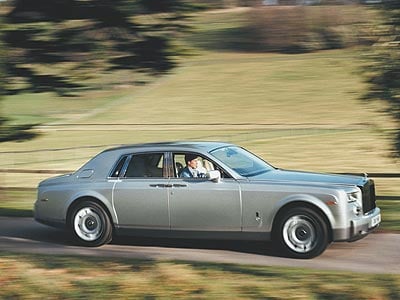

 Stay informed! Subscribe here to our weekly newsletter.
Stay informed! Subscribe here to our weekly newsletter.
Under the Skin
The characteristics expected of a Rolls-Royce engine are uncompromising. It must be supremely smooth, quiet and refined with effortless urge available from tick-over - and then on up through the revs - “wafting” the occupants along on a wave of torque. Paying heed to more modern demands, it has also to be clean, fuel-efficient and supremely reliable.
So a large, normally-aspirated V12 with enormous reserves of low-down torque seemed to fit the bill. Hence the purpose-designed 6.75-litre V12, with its 453bhp and (gulp) 531lb ft of torque taking the Phantom from 0-60mph in 5.7 seconds. (Oh, and 75% of that 531lb ft is available from 1,000rpm.) Drive is to the rear wheels via a ‘shift-by-wire’ six speed automatic transmission.
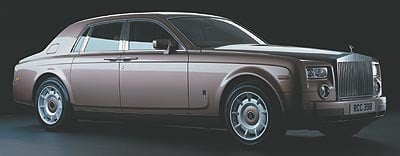
As for the chassis, Rolls-Royce has chosen an aluminium spaceframe with its valuable combination of lightness, torsional rigidity and strength. But it has an additional advantage, appropriate to the new-but-traditional enterprise: it enables the development of bespoke body designs. In marketing speak, it’s a car which can be “structurally tailored to meet the needs and desires of the customer”.
There are also some luxurious yet practical touches, such as the Spirit of Ecstasy which sinks out of sight at the touch of a button; or the purpose-designed umbrellas which fit neatly in the doors. I can’t think of a practical reason for the synchronised wheel centres, which keep the RR badges on all four wheels upright at all times – but then, who needs one?
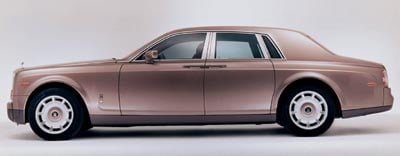
Interior Comfort
The quality of the interior, and the comfort of driver and passengers, is surely a vital consideration in any Rolls-Royce. Quiet and comfort are taken for granted but the car should also offer everyone a good view of the road ahead, a social environment and – although most owners are likely to drive the new Phantom themselves - a certain sense of privacy for rear passengers without resorting to smoked glass or blinds.
The Phantom’s seats are therefore positioned high for “comfort and authority”. In the rear a curved lounge seat makes it a more sociable place to sit, set well back in the motor car to enhance safety and “a degree of discretion”.
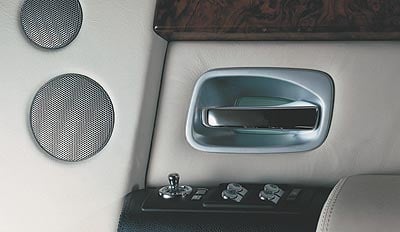
And what about getting into and out of the car? How can it be made easy, comfortable - and elegant? By returning to an idea first seen decades ago, using rear-hinged doors at the back. (Rolls-Royce calls them “coach doors”, although the rest of us are probably more familiar with the term “suicide doors”.) When these rear-hinged doors are combined with a flat floor, passengers simply walk in to the rear compartment, turn and sit down. No awkward squirming and wriggling, says Rolls-Royce.
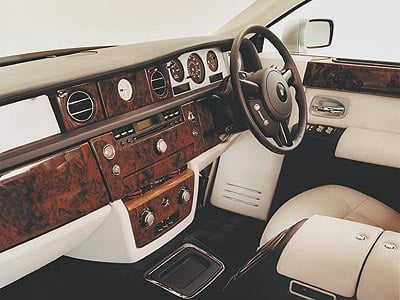

The Facts:Rolls-Royce Phantom
| Engine: | 6,749cc V12; four valves per cylinder, direct fuel injection. |
| Power: | 453bhp at 5,350rpm. |
| Torque: | 531lb ft at 3,500rpm. |
| Transmission: | 6-speed ‘shift-by-wire’ automatic gearbox with rear-wheel drive. |
| Chassis/body: | Aluminium spaceframe, 4-door, 5-seater saloon. |
| Suspension: | Self-levelling air springs, electronic dampers, multi-link rear, double wishbone front. |
| Brakes: | Front: Ventilated discs, 374mm diameter Rear: Ventilated discs, 370mm diameter |
| Steering: | Rack-and-pinion power steering with speed-related power assistance |
| Wheels/tyres: | PAX 265 x 540 A with PAX 265 x 790 R540 A 111W. |
| Dimensions: | 5,834mm long; 1,990mm wide; 1,632mm high; 3,570mm wheelbase. Fuel tank capacity: 100 litres. Gross weight: 3,030kg. . |
| Claimed performance figures: | 0-60mph(97kph): 5.7sec. Top speed – 149mph (limited). Combined fuel consumption – 17.8mpg. |
| Price & availability: | On sale now, priced at EUR320,000 excluding tax. |





